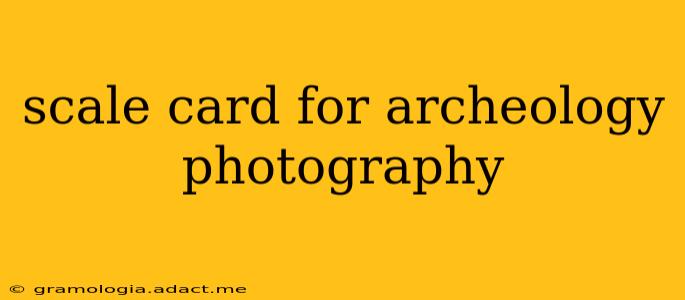Archaeological photography requires meticulous documentation to accurately represent finds and their context. A crucial element of this process is using a scale card—a device that provides a consistent reference for size and perspective in your photographs. This guide will cover everything you need to know about creating and effectively using a scale card for your archaeological photography.
What is a Scale Card in Archaeology?
A scale card, also known as a scale ruler or scale bar, is a simple yet essential tool. It's a flat object (often made of sturdy plastic or metal) marked with precise measurements, usually in centimeters and millimeters. It's placed within the photograph's frame alongside the artifact or site being documented, providing a clear visual indication of its size. This prevents misinterpretations and ensures accurate record-keeping. Without a scale card, it’s impossible to accurately judge the size of objects in photographs, particularly when context is removed during post-processing or viewing.
Why is a Scale Card Essential for Archaeological Photography?
The importance of a scale card in archaeological photography cannot be overstated. It serves several vital purposes:
- Accurate Size Representation: This is the most obvious benefit. A scale card directly shows the size of artifacts, features, and contexts.
- Record Keeping and Analysis: Accurate size is crucial for analysis and comparison of finds. Measurements are essential data points in archaeological reports.
- Contextual Understanding: The scale card helps establish the scale of the surrounding environment in relation to the artifact. A small artifact might seem insignificant without proper scale.
- Legal and Scientific Validity: Photographs with a scale card are admissible in courts and recognized by scientific communities as credible records.
- Future Reference: Decades later, when reviewing photographs, the scale card ensures the sizes of objects remain unequivocally clear, regardless of memory lapses or changes in interpretation.
What are the Different Types of Scale Cards?
While the fundamental purpose remains the same, scale cards can vary in design and material:
- Simple Ruler Cards: These are the most common and inexpensive. They're typically flat cards printed with centimeter and millimeter markings.
- Durable Plastic or Metal Cards: These are more resistant to damage and suitable for fieldwork in challenging conditions.
- Custom-Designed Cards: Some archaeologists prefer custom cards with specific markings or logos, enhancing their branding or study-specific needs.
- Digital Scale Cards (Software Generated): While not physical, some software allows for the creation of a digital scale that can be added to photographs during post-processing. This should be used with extreme caution and requires detailed metadata recording to ensure integrity.
What information should be included on my scale card?
While the measurements are paramount, consider these additional details for enhanced clarity:
- Clear and Bold Markings: Ensure the markings are easily visible, even in low-light conditions.
- Unit of Measurement: Clearly indicate whether the markings are in centimeters, millimeters, or inches.
- Date and Location: Including the date and location of the photograph can help with organizational clarity.
- Project Name or Number: This can be especially useful when managing multiple projects simultaneously.
- Photographer's Initials: This provides accountability and traceability.
How to Use a Scale Card Effectively?
- Placement: The scale card should be placed in the photograph's frame alongside the subject, ensuring both are in sharp focus. Ideally, it should be close enough to the object to clearly relate their sizes.
- Orientation: Keep the scale card parallel to the object's main axis for the clearest measurement reference.
- Lighting: Ensure the card is well-lit, so markings remain easily visible. Avoid harsh shadows that obscure the measurements.
- Consistency: Use the same scale card throughout a project to maintain consistency and avoid confusion.
How do I make my own scale card?
Creating your own scale card is easy and cost-effective. Use durable material like plastic or laminated cardstock. Clearly print or draw the markings with a permanent marker. Ensure the markings are accurate and consistent. Numerous online templates are available if you need design assistance.
What if I forgot to use a scale card?
While always preferable to use a scale card, if you've forgotten, consider using a known object of a known size as a visual reference. You should however always state this clearly within any documentation you create. This alternative is significantly less accurate than using a proper scale card.
Are there any legal considerations regarding scale cards in archaeological photography?
The legal aspects of archaeological photography depend on the location and governing laws. Always adhere to local regulations and obtain necessary permits before conducting any fieldwork and photography. Proper documentation, including the use of scale cards, is vital for demonstrating compliance and ensuring legal validity.
This comprehensive guide should equip you with all the necessary knowledge to use a scale card effectively in your archaeological photography. Remember, the scale card is a fundamental tool for ensuring the accuracy, validity, and longevity of your archaeological records.
